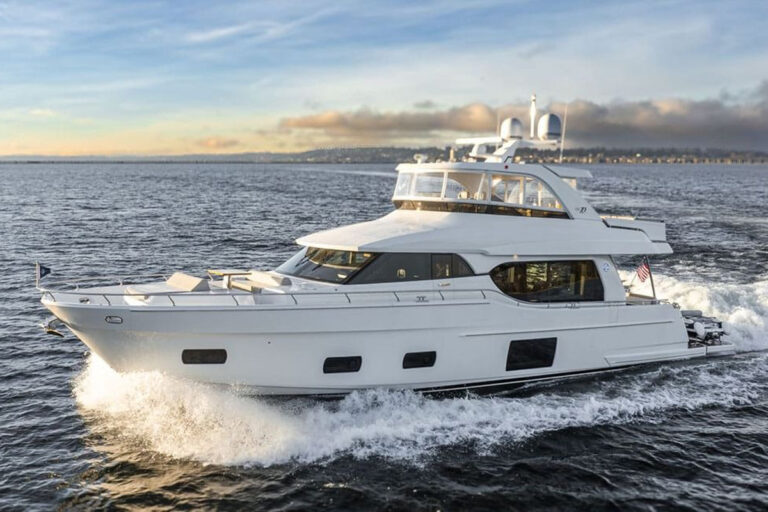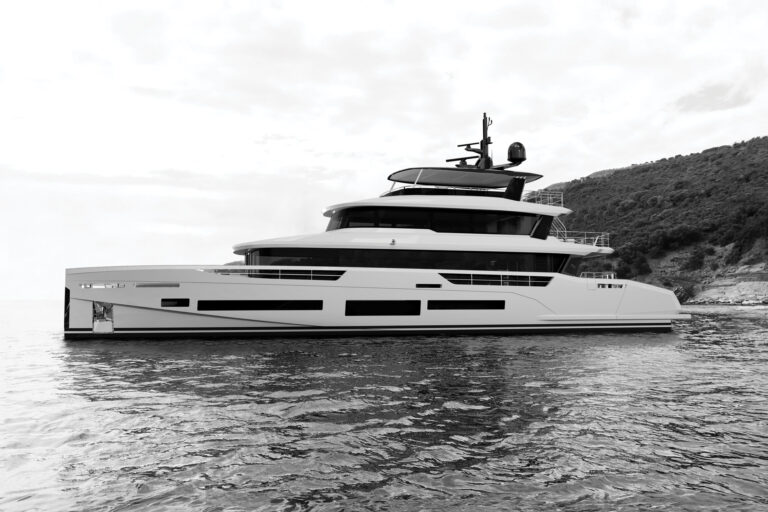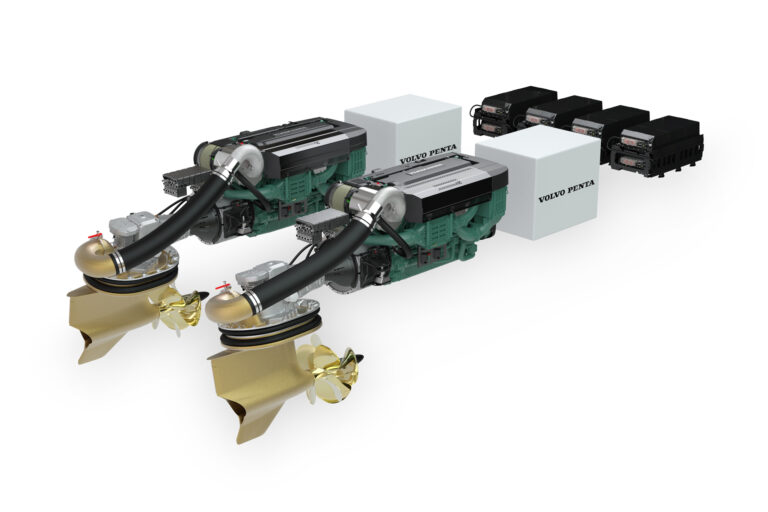
Beam: 23’6″
Draft: 3’0″
Displ.: 47,620 lb. (light)
Fuel: 461 gal.
Water: 206 gal.
Deadrise: N/A
Engines (tested): 2 x 330 hp Volvo Penta D6 diesels
Base Price: Upon request
Billy Black
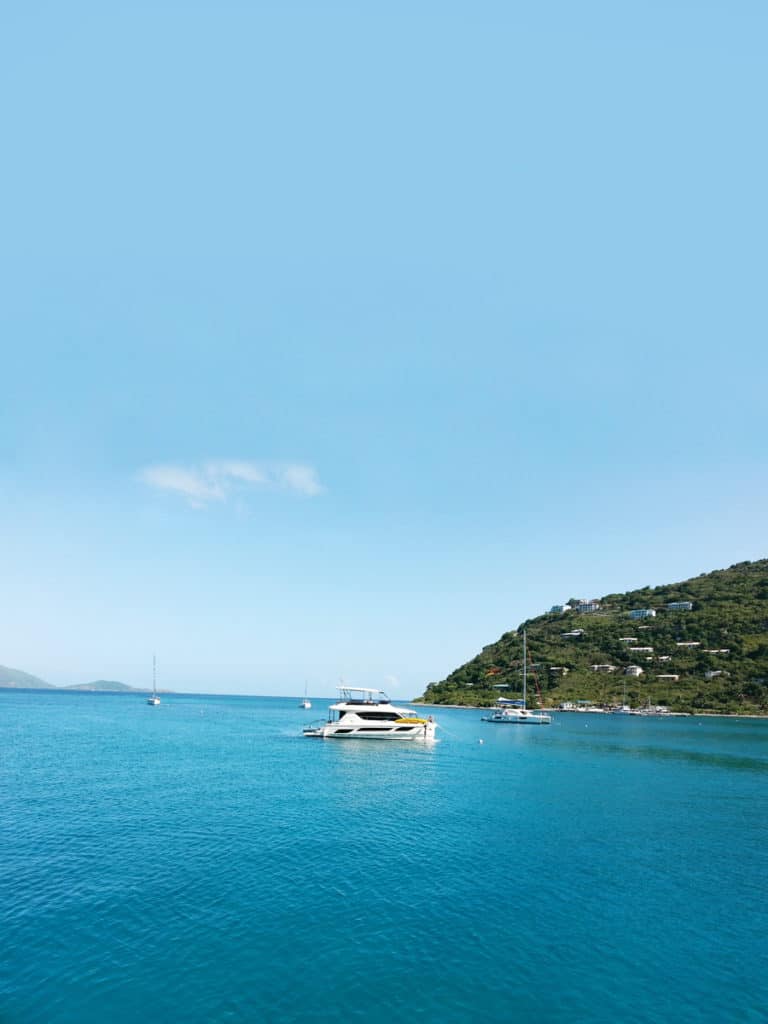
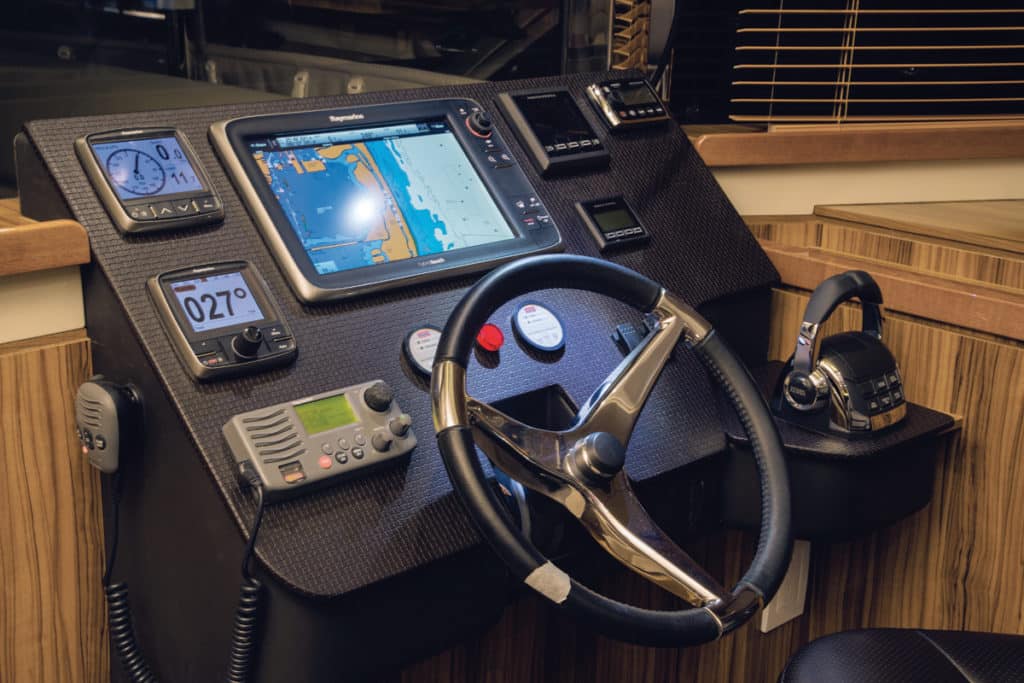
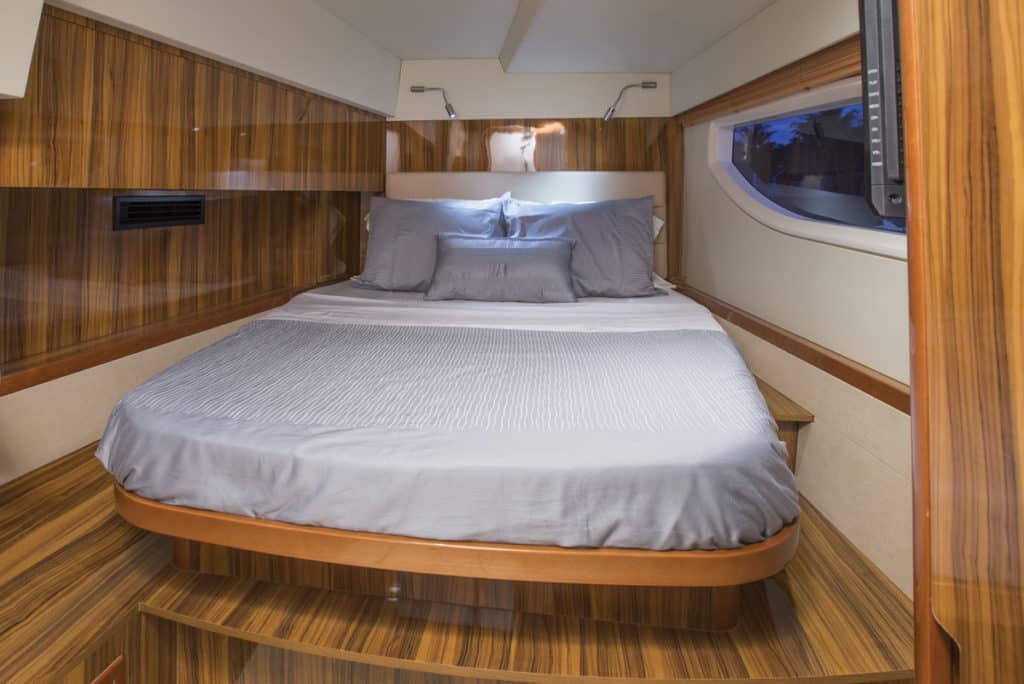
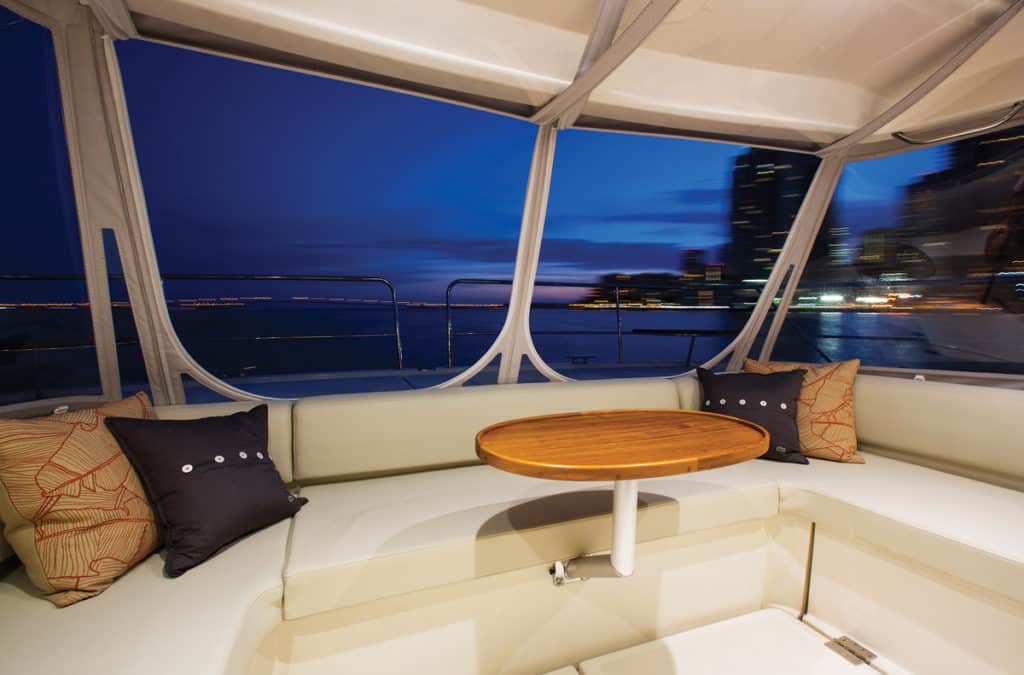

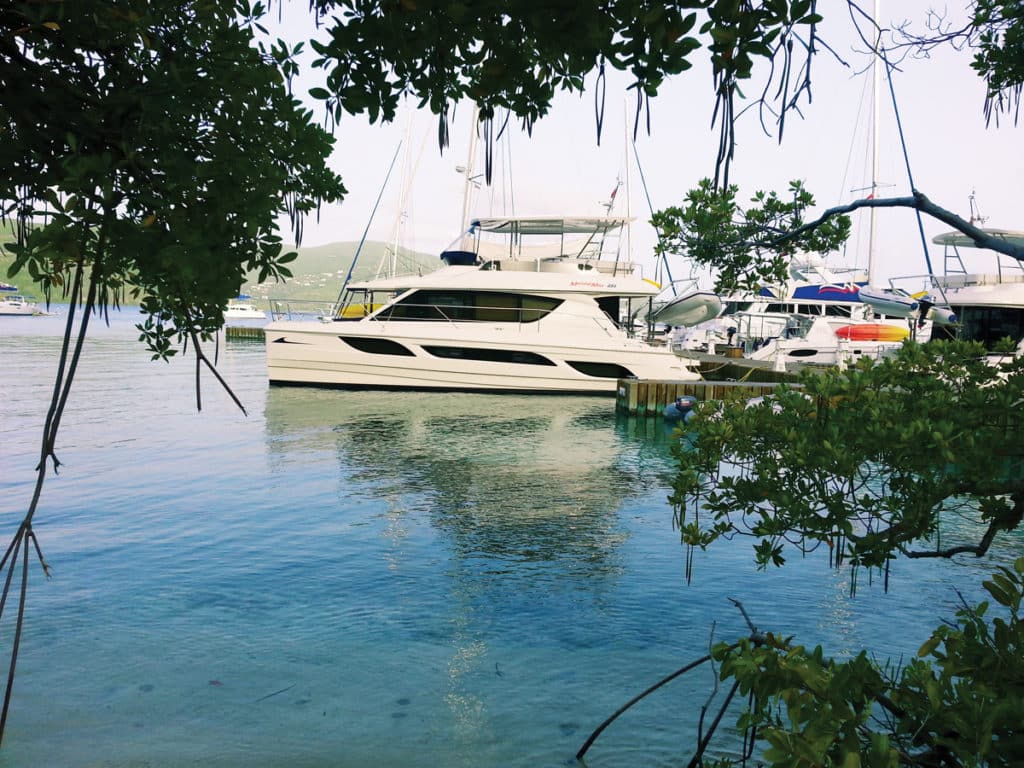
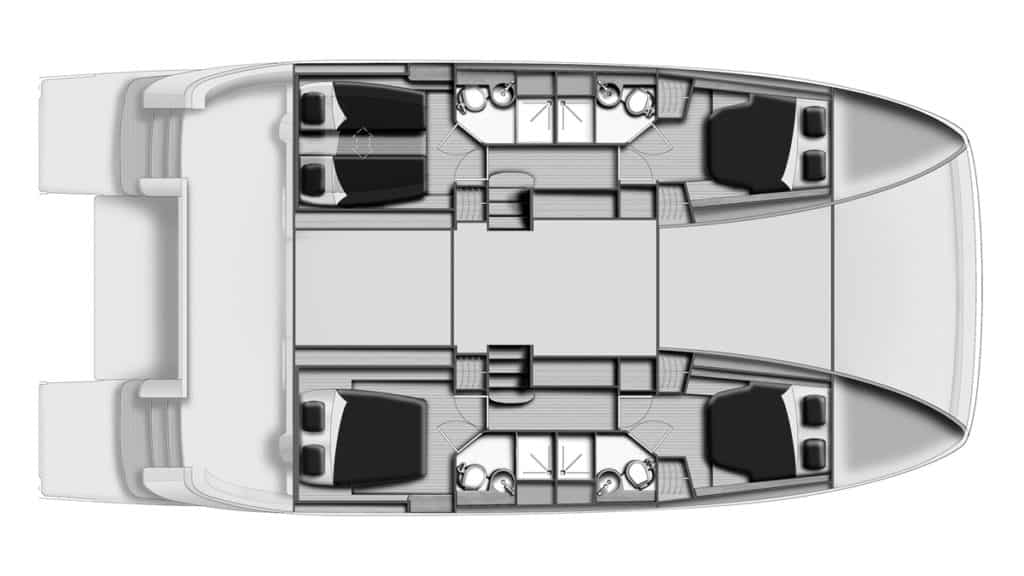

In the world of automobiles, everyone knows about the “trickle down” from racing, where knowledge earned on the racetrack winds up on family cars in areas from rearview mirrors to tires. This happens in yachting too. America’s Cup gear ends up on family sailboats, and design data from racing powerboats improves center-console fishing boats. Now there’s a new “trickle down” from the world of bareboat charters, and it’s to benefit the buyers of power catamarans. The bareboat charter business is tough because, during peak season, turnaround times may be just four hours between one client stepping off and another getting aboard. That doesn’t give much time to clean and wash the boat, let alone fix things that may have broken on the last trip.
In the past, boats used for bareboat charters were production yachts designed for private owners and, as such, didn’t lend themselves to those four-hour turnarounds. There were more drawbacks: Gear was hard to access, the finishes weren’t durable, and even preventive maintenance was difficult.
Then MarineMax, one of the world’s largest boat retailers, entered the bareboat charter business by launching MarineMax Vacations. Headed by the seasoned bareboat team of Lex Raas and Raul Bermudez, MarineMax Vacations became a major player overnight.
An early decision was to design, build and charter its own power catamarans, and if you think bareboat is synonymous with bare bones, think again. These are beautifully crafted yachts with standard features that include Spectra watermakers, Northern Lights generators, Dometic air conditioning and more. The Aquila 48 now being offered is a privatized and glamorized sister to the MarineMax 484.
Raas and Bermudez knew what was needed for both charter and private use, and the Aquila 48 is truly innovative.
A common issue during bareboat charters is running into things. The MarineMax Vacations team knew the stern often takes a beating from inexperienced skippers trying to back toward piers or bulkheads, so each 48 hull has a separately molded “pod” at the transom. This allows for fast and inexpensive replacement in case of crunches, and it’s watertight if the stern is holed.
The same thinking was carried forward, with watertight crash bulkheads. And even if a hull takes on water, all the electrical systems, such as the VHF and nav gear, will keep working because the wire runs and batteries are placed above the hull tunnels.
Then there is getting from the flybridge to the foredeck when anchoring or picking up a mooring. In the past, you had to go aft to a ladder into the cockpit, tiptoe around the side deck and finally reach the foredeck. On the 48, a pair of gentle stairs lead from each side of the bridge directly to the foredeck. Easy and safe for line handling, especially when operating short-handed.
Another example: The cockpit has traditionally been at the stern, so any cooling breeze is blocked by the cabin when sitting at anchor, turning the cockpit into a sweltering hot spot. On this yacht, just open a door from the salon and step into a forward cockpit, shaded by the flybridge overhang and complete with wraparound seating and a folding table for enjoying sundowners.
On my test boat, this had been enclosed with hinged Lexan panels to create an all-weather front porch that can also open for alfresco dining. You wouldn’t send people forward on most boats when running, but the forward cockpit on the 48 is safe in calm conditions for everyone to enjoy the sights and perhaps even a little spray.
With a 23-foot-6-inch beam, this boat has a spacious salon with a dining table and wraparound settee, plus a galley with every required amenity including a Kenyon induction cooktop for flame-free safety. Instead of the usual pop-up TV found on many yachts, the 48 has a flat-screen unit mounted on a roller track so it slides from stowage into the perfect viewing location opposite the dinette. Our test boat had the optional lower helm, a compact dash pod with the Raymarine electronics and a double-wide helm seat. Without the lower helm, you get a couch to starboard.
The decor is pleasant with oversize windows for light, and our boat featured a warm olive wood, a likable and striated finish. A matte cherry is also available.
The MarineMax team continued its fresh thinking with the accommodations. Two layouts are available: a four-cabin version and an owner’s arrangement with three. The four-cabin is intended for charter use, placing two double staterooms at each end of the hulls, giving the maximum privacy and separation. No cabin on a 48 shares a bulkhead with another cabin, and each cabin has a private head with a full-size shower stall, which, combined with the Spectra watermaker, makes long, hot showers possible for all on board.
I tested the owner’s version, which has two guest cabins in the starboard hull, but the entire port hull becomes a master suite. The queen-size berth is still aft, but the head now fills the forward end of the hull with a large-stall shower with teak grate and seat, vessel sink and Dometic electric head.
Amidships in the owner’s cabin are hanging lockers inboard, with a lounge and bureau with drawers opposite. Stowage throughout is excellent, and cabinets are fitted with rails to help keep things stored on top in place. Of particular note, every cabin has oversize windows for a spectacular view when you awaken.
On the aft deck, custom hydraulic davits make launching a 14-foot RIB as easy as pushing a button. Even better, a lowering transom platform between the hulls can be above water to make boarding the tender easy, or it can be lowered to become a water-level “beach” for swimming.
The flybridge, which is immense, has another dining area aft with folding table, shaded by a fiberglass hardtop. This top extends forward to cover the centerline helm featuring a Raymarine e12 hybrid touch-screen display with multifunction electronics package including GPS, chart plotter and autopilot. On each side of the helm console are sun pads that double as seating. Behind the four-wide helm bench seat is an outdoor galley and wet bar with sink, Kenyon barbecue grill and fridge.
My test 48 had a full bridge enclosure with cleverly designed sliding Lexan doors. This was under the hardtop, leaving walk-around room on the outside as well as access to the inside stairway to the salon. This boat also had the optional air conditioning on the bridge. If it’s possible on a 48-footer, this truly became a sky lounge.
Power for my Aquila 48 was an optional pair of 330-horsepower Volvo Penta D6 diesels with V-drives that push the boat to a shade over 20 knots, and perhaps a little more in perfect conditions. Not ocean-pounder performance, of course, but a speed you can maintain in seas that would slow faster boats to a crawl. I found during my test that 2,000 rpm, which should give the diesels a very long life, move the 48 along at 8.5 knots while using just 8 gph.
Standard engines for the Aquila 48 are twin 225-horsepower Volvo Penta D4 diesels, and options range up to twin 370-horsepower D6s.
I mentioned access earlier, and the Aquila 48’s engines are fully accessible without difficulty (remember the four-hour turnaround?) from oil filters to batteries.
And, instead of jamming the Northern Lights 16 kW generator (generously sized so it will never overload, even during a party with the air-conditioner, microwave and blenders for pina coladas running constantly) into the engine room, the genset has its own watertight compartment forward, again with great accessibility.
Further uncrowding the machinery spaces, the watermaker is also forward in another compartment, and this area is dedicated to fresh water with double pumps for redundancy, carefully plumbed piping and a user-friendly watermaker. Get this: There’s full standing headroom so there is no need to crawl around on your knees.
The Aquila 48 is well-built, using resin infusion with vinylester resin for blister protection. Coring is balsa, and it’s been perforated before the infusion, so the resin penetrates the balsa to create sturdy I-beams. And, should water penetrate the core from a hole, the water can’t migrate through the core, limiting the damaged area.
The props are set into pockets, creating just a 3-foot draft, which, in a way, is its own safety factor when cruising skinny waters.
Power cats like the Aquila 48 are renowned for their agility because the widely separated props allow the boat to be twisted and turned into the tightest of slips; on top of that, our test boat had the optional Lewmar electric bow thrusters. When two of us were docking in a strong crosswind, the natural nimbleness of the 48 combined with the bow thrusters for easy placement. At that point, I could skip down the forward stairs from the bridge to handle the foredeck lines while my mate was aft in the cockpit.
By now, it’s obvious I really like the Aquila 48. Were I in the market, I’d buy one in a hot second. I like the innovative thinking in the design. I like that all the systems are overengineered and redundant for easy maintenance. I like the sturdy construction and the layout that provides the space and privacy of much larger yachts.
Best of all, you can charter one for a week through MarineMax Vacations before you sign the contract. Be forewarned, though, because I know that will seal the deal.
MarineMax, 888-429-6812; marinemax.com






